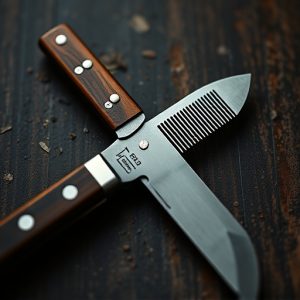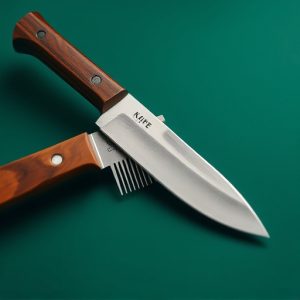The Hidden Blade Comb: A Historical and Safety Perspective on This Controversial Multi-Tool
The comb with a hidden knife is an intriguing historical artifact that has evolved from a status sy…….
The comb with a hidden knife is an intriguing historical artifact that has evolved from a status symbol of the Renaissance to a versatile modern tool. Its design cleverly blends everyday grooming functionality with concealed defensive capabilities, reflecting both societal shifts and technological advancements over the centuries. Originally accessible only to the affluent during the industrial revolution, these combs have become more widespread, serving various roles from personal care to espionage. Legally, they are subject to diverse regulations across different regions, with authorities scrutinizing their possession based on intent and potential circumvention of knife control laws. The societal perception of comb knives varies, with some viewing them as practical self-defense tools and others perceiving them with suspicion. Safety is paramount in their design, with manufacturers adhering to strict protocols to ensure child resistance and prevent accidental blade deployment. Users are advised to be well-informed about the legal standards of their jurisdiction to avoid penalties. Today, comb knives exemplify creative design innovation, seamlessly integrated into everyday objects for both utility and tactical purposes, highlighting their relevance in contemporary society as a nod to historical ingenuity.
Exploring the intricate history and function of objects that blend utility with concealed utility, this article delves into the multifaceted world of the ‘comb with hidden knife.’ From its enigmatic origins to modern adaptations, we uncover the design prowess, societal implications, legal standpoints, and safety measures surrounding these ingenious artifacts. Join us as we dissect the layers behind this remarkable invention, where form meets function in unexpected ways.
Unraveling the Mysteries of the Comb with Hidden Knife: A Historical Overview
The combination of a comb with an ingeniously concealed knife has a storied history that spans across various cultures and time periods. This multifunctional tool, which seamlessly integrates the utilitarian purposes of grooming with the potential for self-defense or clandestine activities, has intrigued historians and collectors alike. The earliest known examples of combs with hidden blades can be traced back to the Renaissance period, where they were often ornate and crafted for the upper echelons of society. These artifacts were not only symbols of status but also practical items for individuals who desired to maintain a polished appearance while possessing a tool that could serve as a swift defense mechanism in times of danger.
The design of such artifacts evolved over the centuries, with each iteration reflecting the technological advancements and social norms of its era. During the 19th century, for instance, the industrial revolution brought about mass production and more accessible designs. The comb with a hidden knife became a staple in the lives of many, serving not only as a grooming aid but also as a tool for survival or subterfuge. Throughout history, these combs have been featured in various capacities, from everyday use to roles in espionage and covert operations, where their dual functionality proved invaluable. The study of such items offers a unique window into the socio-cultural dynamics of past societies, revealing much about their values, fears, and inventiveness.
Design and Mechanism: The Ingenuity Behind the Comb with Hidden Knife
The “comb with hidden knife” is an intriguing fusion of everyday utility items, expertly designed to seamlessly blend practicality with concealed functionality. At first glance, this innovative tool appears to be nothing more than a standard comb, its teeth finely crafted for the task of grooming hair. However, upon closer inspection, the design reveals its true ingenuity: within the structure of the comb, a meticulously hidden blade resides. The mechanism that allows the transition from a harmless hair accessory to a versatile cutting tool is a marvel of engineering. Typically, a discreet button or lever, often integrated into the comb’s handle or near the base, activates the release of the knife. This feature ensures that the blade remains securely in place until intentionally deployed by the user, maintaining a low profile and eliminating accidental exposure. The design takes into account ergonomics and balance, ensuring that both the comb and knife functions are effective without compromising each other’s performance. The combination of these elements results in a tool that is both versatile and subtle, making it an ideal companion for individuals who require the dual functionality for various situations, whether for personal care or unexpected needs in their immediate environment.
Legal Implications and Societal Perceptions of the Comb with Hidden Knife
The act of carrying a comb with a concealed knife, often colloquially referred to as a “comb knife,” navigates a complex intersection of legal implications and societal perceptions. Legally, the possession of such an item is subject to stringent regulations varying by jurisdiction. In many regions, tools that serve dual purposes are scrutinized under weapon laws, with the intent of the carrier being a critical factor in legal determination. The presence of a knife within an everyday object like a comb can be seen as an attempt to circumvent knife control laws, leading to potential charges for unlawful carrying or possession of a weapon. Authorities typically examine the context in which the item is carried, considering factors such as the individual’s intent and the local legal framework governing weapon carriage.
Societal perceptions of the comb with a hidden knife are equally nuanced. In some communities, this practice may be viewed as a practical solution for individuals desiring to carry a tool for self-defense without drawing attention or violating regulations against openly carrying knives. However, in other societies, such items are perceived with suspicion and fear, stigmatizing those who possess them as potentially dangerous or lawbreakers. The societal response is often shaped by the prevalence of violent crime, media portrayals, and the effectiveness of public education on weapon safety and laws. The perception of these comb knives as either a harmless multifunctional tool or a covert weapon thus depends heavily on cultural norms and legal contexts.
Safety Considerations and Regulations Governing the Production and Ownership of Combs with Hidden Knives
The integration of a concealed blade within a comb, while serving a practical purpose for certain individuals, necessitates careful consideration of safety and legal regulations. Manufacturers must adhere to stringent standards to ensure that these multifunctional tools are both safe and effective. Safety features such as child-resistant mechanisms are integral to prevent unauthorized access to the knife, which poses a significant hazard to children and unsuspecting users. The design of the comb-knife must be user-friendly, with clear indications of its dual functionality to avoid accidental injuries.
Legal frameworks governing the production and ownership of combs with hidden knives vary by jurisdiction. In regions where such items are legal, regulations often dictate specific design criteria to minimize risks. These may include limitations on the blade’s length, the strength required to deploy the knife, and the visibility of the knife when it is not in use. Owners must be aware of and comply with these laws; failure to do so can result in severe penalties due to misuse or misconception of the item’s intended purpose. Users are encouraged to familiarize themselves with local legislation before acquiring or using a comb with a hidden knife to ensure they remain within the bounds of the law.
Modern Adaptations: The Evolution of the Comb with Hidden Knife in Everyday Objects
The concept of a comb with a hidden knife, once a feature primarily found in utility items for survival situations, has seen a remarkable evolution to adapt to modern societal norms and legal restrictions. Today, this design is subtly integrated into everyday objects, often for practical purposes such as personal safety or tactical use. The transformation from overt multifunctional tools to discreet, covertly designed accessories reflects a shift in both the perception of these items and their intended use. Manufacturers have innovated, creating objects that serve multiple functions without drawing undue attention to the knife component. These modern adaptations are often found in items like combs, pens, and even bracelets, where the blade is cleverly concealed yet readily accessible for those who require its use for protection or in emergency situations. The integration of such features into objects commonly carried by individuals has become a testament to the ingenuity of designers who balance form and function while respecting legal and social boundaries. The comb with hidden knife thus remains a symbol of both historical utility and contemporary innovation, blending seamlessly into the fabric of daily life while offering an added layer of security or practicality when needed.


